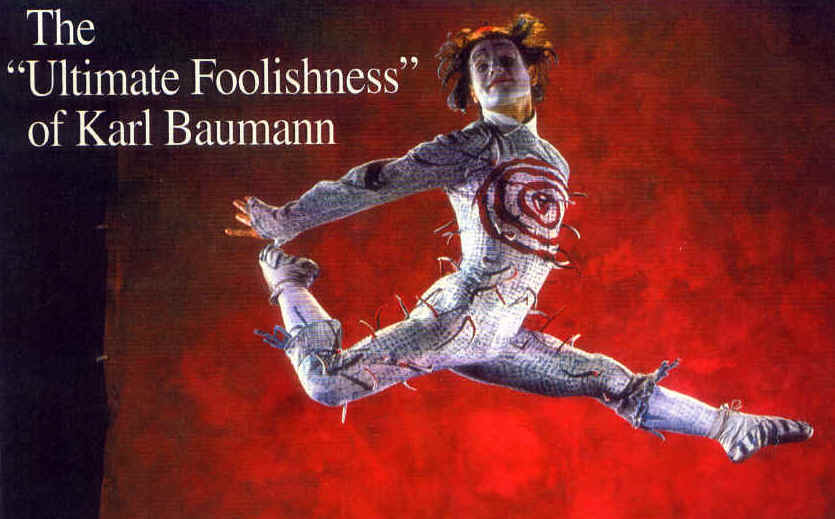
The dance technique of some of the acrobats in Quidam can be a bit rough around the edges, and the interludes of pure dance are mostly comic. The notable exception is Austrian-born Karl Baumann, who plays Fritz, a scampering sprite of a sidekick to the lanky, cranky Ringmaster of the American juggler John Gilkey. Baumann's impish, fairy-like character exudes the spirit of commedia dell'arte and the red-and-blue target design on his chest (echoed several times in the show) emphasizes his role as the circus heart of the production. The numerous prickly spikes attached to his costume recall the suffering of St. Sebastian, but Baumann's Fritz remains lighthearted and gaily acrobatic.
Born thirty-six years ago in Salzburg, Baumann received the sort of eclectic education (engineering and classical guitar, as well as ballet and modern dance at Juilliard) that makes him a natural for Cirque. His dancing credits include work with Moses Pendleton, appearances at BAM's Next Wave Festival, and tenures with the Berlin Opera, the Munich State Opera, and Momix. He was a principal dancer and choreographer for Momix from 1989 to 1993, the year he joined Cirque. Recalling the audition, he says, "Debbie and I connected right away. We spoke the same language." He was eventually cast as a dancing lizard in Mystere and imbued the role with such personality that Dragone decided to make him a main character in Quidam. Baumann seems to have run away to the circus for good and may never return to the world of concert dance. He likes the excitement and experimental nature of Cirque and enjoys the movement possibilities opened up by apparatus not commonly found on concert dance stages.
In Quidam he spends time hanging and spinning on high ropes in an act known as "Spanish Webs," where his dancerly polish is particularly oustanding. "Being around acrobats," he says, "you can't avoid learning acrobatics." In spite of the directors' initial skepticism, Baumann diligently practiced the rope work over the course of an entire year and eventually won the opportunity to take part in the act. "It would be good training for any dancer to spend a little time upside down," he says. "Dancers may not realize that there can be a place for them in a show like this." Baumann confides that Brown challenges him to "go all the way" with his improvisational creativity, that her vitality and enthusiasm have a way of possessing those she works with.
During her journey, the young girl in Quidam meets characters hovering "on the border between life and ultimate foolishness." Gilkey's Ringmaster and Baumann's Fritz have stepped across that border and entered what Baumann calls "the live Fellini movie" that is Cirque. For the duration of the enchanting two-and-a-half-hour journey, the audience can't resist following them. "The whole world is yearning for more spirit and fantasy," Baumann says. "We bring the audience into that dimension."